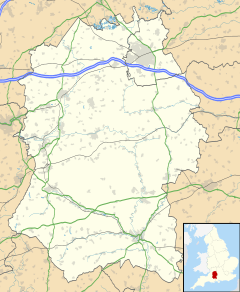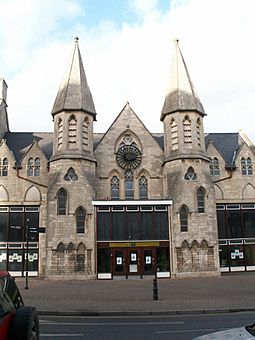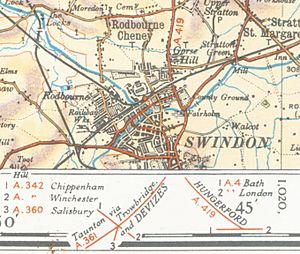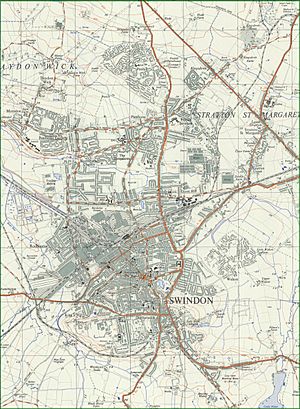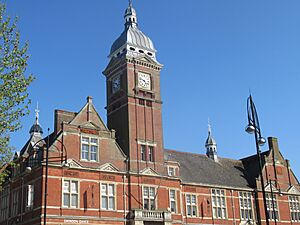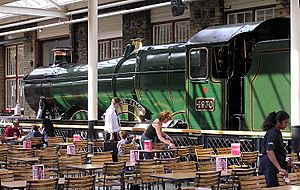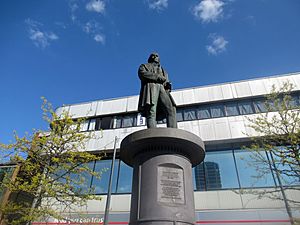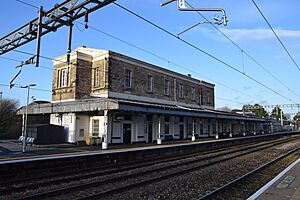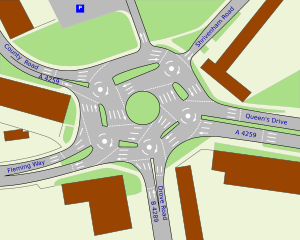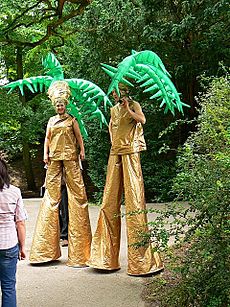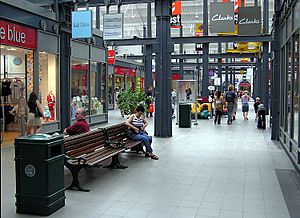Swindon facts for kids
Quick facts for kids Swindon |
|
|---|---|
| Town | |
 Central Swindon seen from Radnor Street Cemetery in 2019 |
|
| Population | 183,638 |
| OS grid reference | SU152842 |
| • London | 71 miles (114 km) |
| Unitary authority |
|
| Ceremonial county | |
| Region | |
| Country | England |
| Sovereign state | United Kingdom |
| Post town | SWINDON |
| Postcode district | SN1–SN6, SN25, SN26 |
| Dialling code | 01793 |
| Police | Wiltshire |
| Fire | Wiltshire |
| Ambulance | Great Western |
| EU Parliament | South West England |
| UK Parliament |
|
Swindon (![]() i/ˈswɪndən/) is a town in Wiltshire, England. At the time of the 2021 Census the population of the built-up area was 183,638, making it the largest settlement in the county. Located in South West England, Swindon lies on the M4 corridor, 71 miles (114km) to the west of London and 36 miles (57 km) to the east of Bristol. The Cotswolds lie just to the town's north and the North Wessex Downs to its south.
i/ˈswɪndən/) is a town in Wiltshire, England. At the time of the 2021 Census the population of the built-up area was 183,638, making it the largest settlement in the county. Located in South West England, Swindon lies on the M4 corridor, 71 miles (114km) to the west of London and 36 miles (57 km) to the east of Bristol. The Cotswolds lie just to the town's north and the North Wessex Downs to its south.
Recorded in the 1086 Domesday Book as Suindune, the arrival of the Great Western Railway in 1843 transformed it from a small market town of 2,500 into a thriving railway hub that would become one of the largest railway engineering complexes in the world at its peak. This brought with it pioneering amenities such as the UK's first lending library and a 'cradle-to-grave' healthcare centre that was later used as a blueprint for the NHS. Swindon's railway heritage can be primarily seen today with the grade 2 listed Railway Village and STEAM Museum. The McArthurGlen Designer Outlet is housed in the renovated former works and the Brunel Shopping Centre is one of several places in Swindon that bear the name of the famous engineer generally acknowledged with bringing the railways to the town.
Despite the subsequent decline and closure of its railway works, Swindon was one of the fastest growing towns in Europe post-war as its economy diversified, attracting large international companies, who made use of its burgeoning population and strategic transport links.
Major venues in the town include the Wyvern Theatre and the Mechanics' Institute. Lydiard Park has hosted festivals such as BBC Radio 1's Big Weekend, while the Swindon Mela, an all-day celebration of South Indian arts and culture, attracts up to 10,000 visitors a year. The ancient Ridgeway, known as Britain's oldest road, runs a few miles to Swindon's south, with Avebury, the largest megalithic stone circle in the world, and Uffington White Horse, Britain's oldest white horse figure, also nearby. Wiltshire's only professional football club Swindon Town F.C., have played in the Premier League in the 1993/94 season and won a major trophy, securing a famous giant-killing victory over Arsenal in the 1969 League Cup final. They currently play in League Two at the 15,000-seat County Ground in the town centre. Other sports in the town include Swindon Wildcats Ice Hockey and five-time British speedway champions the Swindon Robins.
Contents
History
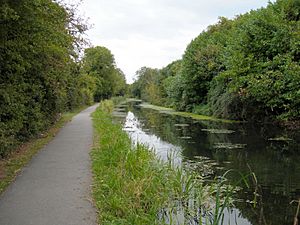
Early history
The original Anglo-Saxon settlement of Swindon sat in a defensible position atop a limestone hill. It is referred to in the Domesday Book as Suindune, believed to be derived from the Old English words "swine" and "dun" meaning "pig hill" or possibly Sweyn's hill, where Sweyn is a personal name.
Swindon was a small market town, mainly for barter trade, until roughly 1848. This original market area is on top of the hill in central Swindon, now known as Old Town.
The Industrial Revolution was responsible for an acceleration of Swindon's growth. It started with the construction of the Wilts and Berks Canal in 1810 and the North Wilts Canal in 1819. The canals brought trade to the area and Swindon's population started to grow.
Railway town
Between 1841 and 1842, Isambard Kingdom Brunel's Swindon Works was built for the repair and maintenance of locomotives on the Great Western Railway (GWR). The GWR built a small railway village to house some of its workers. The Steam Railway Museum and English Heritage, including the English Heritage Archive, now occupy part of the old works. In the village were the GWR Medical Fund Clinic at Park House and its hospital, both on Faringdon Road, and the 1892 health centre in Milton Road – which housed clinics, a pharmacy, laundries, baths, Turkish baths and swimming pools – was almost opposite.
From 1871, GWR workers had a small amount deducted from their weekly pay and put into a healthcare fund – its doctors could prescribe them or their family members free medicines or send them for medical treatment. In 1878 the fund began providing artificial limbs made by craftsmen from the carriage and wagon works, and nine years later opened its first dental surgery. In his first few months in post the dentist extracted more than 2000 teeth. From the opening in 1892 of the Health Centre, a doctor could also prescribe a haircut or even a bath. The cradle-to-grave extent of this service was later used as a blueprint for the NHS.
The Mechanics' Institute, formed in 1844, moved into a building looking rather like a church and included a covered market, on 1 May 1855. The New Swindon Improvement Company, a co-operative, raised the funds for this path self-improvement and paid the GWR £40 a year for its new home on a site at the heart of the railway village. It was a groundbreaking organisation that transformed the railway's workforce into some of the country's best-educated manual workers.
It had the UK's first lending library, and a range of improving lectures, access to a theatre and a range of activities from ambulance classes to xylophone lessons. A former Institute secretary formed the New Swindon Co-operative Society in 1853 which, after a schism in the society's membership, spawned the New Swindon Industrial Society that ran a retail business from a stall in the market at the Institute. The Institute also nurtured pioneering trades unionists and encouraged local democracy.
When tuberculosis hit the new town, the Mechanics' Institute persuaded the industrial pioneers of North Wiltshire to agree that the railway's former employees should continue to receive medical attention from the doctors of GWR Medical Society Fund, which the Institute had played a role in establishing and funding.
Swindon's 'other' railway, the Swindon, Marlborough and Andover Railway, merged with the Swindon and Cheltenham Extension Railway to form the Midland & South Western Junction Railway, which set out to join the London & South Western Railway with the Midland Railway at Cheltenham. The Swindon, Marlborough & Andover had planned to tunnel under the hill on which Swindon's Old Town stands but the money ran out and the railway ran into Swindon Town railway station, off Devizes Road in the Old Town, skirting the new town to the west, intersecting with the GWR at Rushey Platt and heading north for Cirencester, Cheltenham and the LMS, whose 'Midland Red' livery the M&SWJR adopted.
During the second half of the 19th century, Swindon New Town grew around the main line between London and Bristol. In 1900, the original market town, Old Swindon, merged with its new neighbour at the bottom of the hill to become a single town.
On 1 July 1923, the GWR took over the largely single-track M&SWJR and the line northwards from Swindon Town was diverted to Swindon Junction station, leaving the Town station with only the line south to Andover and Salisbury. The last passenger trains on what had been the SM&A ran on 10 September 1961, 80 years after the railway's first stretch opened.
During the first half of the 20th century, the railway works was the town's largest employer and one of the biggest in the country, employing more than 14,500 workers. Alfred Williams (1877–1930) wrote about his life as a hammerman at the works.
The works' decline started in 1960, when it rolled out Evening Star, the last steam engine to be built in the UK. The works lost its locomotive building role and took on rolling stock maintenance for British Rail. In the late 1970s, much of the works closed and the rest followed in 1986.
The Community Centre in the Railway Village was originally the Barrack accommodation for Railway Employees of the GWR. The building became the Railway Museum in the 1960s, until the opening of the STEAM Museum in the 2000s.
Railway Town is also the name of a feature-length documentary made by local filmmaker Martin Parry about the creation of the town around the railway works.
Modern period
David Murray John, Swindon's town clerk from 1938 to 1974, is seen as a pioneering figure in Swindon's post-war regeneration; his last act before retirement was to sign the contract for Swindon's tallest building, which is now named after him. His successor was David Maxwell Kent, appointed by the Swindon/Highworth Joint Committee in 1973. He had worked closely with David Murray John and continued similar policies for a further twenty years. The Greater London Council withdrew from the Town Development Agreement and the local council continued the development on its own.
There was the problem of the Western Development and of Lydiard Park being in the new North Wiltshire district, but this was resolved by a boundary change to take in part of North Wiltshire. Another factor limiting local decision-taking was the continuing role of Wiltshire County Council in the administration of Swindon. Together with like-minded councils, a campaign was launched to bring an updated form of county borough status to Swindon. This was successful in 1997, and Wiltshire is now divided into two Unitary Councils, both of equal status. One is Wiltshire Council, succeeding the former Wiltshire County Council and the Wiltshire district councils other than Thamesdown, while the other is Swindon Borough Council, covering the area of the former Thamesdown and the former Highworth Rural District Council.
The closure of the railway works (which had been in decline for many years) was a major blow to Swindon.
Because of this and the major growth in population diversification was continued at a rapid pace and the Town now has all the features of a successful urban/rural Council in the Outer South East Zone.
In February 2008 The Times named Swindon as one of "The 20 best places to buy a property in Britain". Only Warrington had a lower ratio of house prices to household income in 2007, with the average household income in Swindon among the highest in the country.
In October 2008 Swindon made a controversial move to ban fixed point speed cameras. The move was branded as reckless by some but by November 2008 Portsmouth, Walsall, and Birmingham councils were also considering the move.
In 2001 construction began on Priory Vale, the third and final instalment in Swindon's 'Northern Expansion' project, which began with Abbey Meads and continued at St Andrew's Ridge. In 2002 the New Swindon Company was formed with the remit of regenerating the town centre, to improve Swindon's regional status. The main areas targeted are Union Square, The Promenade, The Hub, Swindon Central, North Star Village, The Campus and the Public Realm.
Swindon hosted Radio 1's Big Weekend in May 2009 at Lydiard Park. Building on the work of Radio 1, Swindon Borough Council organised the Big Arts Day in 2010. Aiming to be an annual event celebrating the arts it was held at Lydiard Park in July for three consecutive years before being cancelled due to lack of funding.
2016 saw the resurrection of the Children's Fete at GWR Park Faringdon Road on what would have been the events 150th anniversary.
Governance
The local council was created in 1974 as the Borough of Thamesdown, out of the areas of Swindon Borough and Highworth Rural District. It was not initially called Swindon, because the borough covers a larger area than the town; it was renamed as the Borough of Swindon in 1997. The borough became a unitary authority on 1 April 1997, following a review by the Local Government Commission for England. The town is therefore no longer under the auspices of Wiltshire Council.
Council elections are held in three out of every four years, with one-third of the seats up for election in each of those years; beginning in 2026, the whole council will be elected every four years. Labour gained control of the council from the Conservatives at the 2023 election, and increased their majority in 2024.
Swindon is represented in the national parliament by two MPs. Heidi Alexander (Labour) was elected for the Swindon South seat in July 2024 with a 16% swing from the Conservatives. Will Stone, also Labour, represents Swindon North – which covers the whole of the north of the borough, including Blunsdon and Highworth – after a 19% swing at the same election. Prior to 1997 there was a single seat for Swindon, although much of what is now in Swindon was then part of the Devizes seat.
Geography
The town has an area of about 40 square kilometres (15 sq mi).
The landscape is dominated by the chalk hills of the Wiltshire Downs to the south and east. The Old Town stands on a hill of Purbeck and Portland stone; this was quarried from Roman times until the 1950s. The area that was known as New Swindon is made up of mostly Kimmeridge clay with outcrops of Corrallian clay in the areas of Penhill and Pinehurst. Oxford clay makes up the rest of the borough. The River Ray rises at Wroughton and forms much of the borough's western boundary, joining the Thames which defines the northern boundary, and the source of which is located in nearby Kemble, Gloucestershire. The River Cole and its tributaries flow northeastward from the town and form the northeastern boundary.
- Nearby towns: Chippenham, Royal Wootton Bassett, Cirencester, Cricklade, Devizes, Highworth, Marlborough, Malmesbury, Calne
- Nearby villages: Aldbourne, Badbury, Blunsdon, Broad Hinton, Chiseldon, Hook, Lambourn, Liddington, Lydiard Millicent, Minety, Purton, Ramsbury, South Marston, Wanborough, Wroughton
- Nearby places of interest: Avebury, Barbury Castle, Crofton Pumping Station, Lydiard Country Park, Silbury Hill, Stonehenge, Uffington White Horse
- Sites of Special Scientific Interest in Swindon include Coate Water, Great Quarry, Haydon Meadow, Okus Quarry and Old Town Railway Cutting
Climate
Swindon has a maritime climate type, like all of the British Isles, with comparatively mild winters and comparatively cool summers considering its latitude. The nearest official weather station is RAF Lyneham, about 10 miles (16 km) west south west of Swindon town centre. The weather station's elevation is 145 metres, compared to the typical 100 metres encountered around Swindon town centre, so is likely to be marginally cooler throughout the year.
The absolute maximum is 34.9C (94.8F) recorded during August 1990. In an average year the warmest day should reach 28.7C (83.7F) and 10.3 days should register a temperature of 25.1C (77.2F) or above
The absolute minimum is −16.0C (3.0F), recorded in January 1982, and in an average year 45.2 nights of air frost can be expected.
Sunshine, at 1565 hours a year, is typical for inland parts of Southern England, although significantly higher than most areas further north.
Annual rainfall averages slightly under 720 mm (28 in) per year, with 123 days reporting over 1 mm of rain.
| Climate data for Lyneham, elevation 145m, 1971–2000, extremes 1960– | |||||||||||||
|---|---|---|---|---|---|---|---|---|---|---|---|---|---|
| Month | Jan | Feb | Mar | Apr | May | Jun | Jul | Aug | Sep | Oct | Nov | Dec | Year |
| Record high °C (°F) | 13.7 (56.7) |
16.6 (61.9) |
20.0 (68.0) |
25.3 (77.5) |
26.6 (79.9) |
32.7 (90.9) |
34.4 (93.9) |
34.9 (94.8) |
28.8 (83.8) |
26.5 (79.7) |
16.5 (61.7) |
14.4 (57.9) |
34.9 (94.8) |
| Mean daily maximum °C (°F) | 6.6 (43.9) |
6.9 (44.4) |
9.4 (48.9) |
12.0 (53.6) |
15.7 (60.3) |
18.5 (65.3) |
21.2 (70.2) |
20.7 (69.3) |
17.7 (63.9) |
13.6 (56.5) |
9.6 (49.3) |
7.4 (45.3) |
13.3 (55.9) |
| Mean daily minimum °C (°F) | 1.2 (34.2) |
1.0 (33.8) |
2.6 (36.7) |
3.7 (38.7) |
6.7 (44.1) |
9.7 (49.5) |
11.9 (53.4) |
11.8 (53.2) |
9.8 (49.6) |
6.8 (44.2) |
3.7 (38.7) |
2.1 (35.8) |
6.0 (42.8) |
| Record low °C (°F) | −16 (3) |
−11.3 (11.7) |
−8 (18) |
−4.8 (23.4) |
−1.6 (29.1) |
0.6 (33.1) |
3.8 (38.8) |
5.0 (41.0) |
1.5 (34.7) |
−3.6 (25.5) |
−7.8 (18.0) |
−14 (7) |
−16 (3) |
| Average precipitation mm (inches) | 70.1 (2.76) |
50.6 (1.99) |
58.3 (2.30) |
47.7 (1.88) |
51.8 (2.04) |
58.5 (2.30) |
47.2 (1.86) |
56.1 (2.21) |
63.9 (2.52) |
70.4 (2.77) |
66.9 (2.63) |
77.4 (3.05) |
719.0 (28.31) |
| Mean monthly sunshine hours | 55.2 | 72.3 | 108.5 | 156.9 | 196.2 | 194.1 | 212.4 | 197.5 | 144.6 | 107.3 | 71.7 | 48.4 | 1,565 |
| Source 1: Met Office | |||||||||||||
| Source 2: KNMI | |||||||||||||
Demographics
The 2011 census recorded a population of 209,156 people in the Swindon unitary authority area (including the town's urban area, Highworth, and other nearby parishes), with a 50/50 balance of males and females. By mid-2019, the estimated population of the unitary authority area was 222,193.
In 2011, 57.5% of Swindonians identified themselves as Christians, a reduction from 70% in 2001. This was followed by those of no religion (31%), Muslims (1.7%), Sikhs (0.6%), Hindus (1.2%), other (0.5%) and Judaism (0.1%).
As of 2021, 46.6% of Swindonians identify themselves as Christians. This is followed by those of no religion (40.5%), Muslims (2.7%), Sikhs (0.6%), Hindus (2.5%), other (0.6%) and Judaism (0.1%).
In 2015, Public Health England found that 70.4% of the population was either overweight or obese with a BMI greater than 25.
In 2011, the area of the town was 46.2 km2 (17.8 sq mi) and there were 3,949 inhabitants per square kilometre (10,230/sq mi).
| Ethnic Groups | Swindon Town 2011 | Borough of Swindon 2011 | Borough of Swindon 2021 |
|---|---|---|---|
| White British | 83.3% | 84.6% | 74.2% |
| Asian | 7.0% | 6.4% | 11.6% |
| Black | 1.5% | 1.4% | 2.6% |
In 2011, 16.7% of the population of Swindon were non-White British compared with 15.4% in the surrounding borough. There was also little difference between the percentages of Black and Asian residents. Swindon is one of the most ethnically diverse towns in South West England: 4.6% of the population registered themselves as 'Other White' and 2.5% of the population was either mixed race or of another ethnicity.
There are several definitions of the town for statistical purposes. The smallest extent is the former unparished area, now covered by the parishes of West Swindon, Central Swindon North, South Swindon, and Nythe, Eldene and Liden; thus it omits suburbs to the east and north, namely the parishes of Covingham, Stratton St Margaret and Haydon Wick. At the 2011 census, the population of the unparished area was 122,642. The 2011 census also recognised a Built Up Area Subdivision with a population of 182,441.
At the 2021 census, the only area covering most of the town was the Built Up Area, which had a population of 183,638. Excluded from this were the parts of Wichelstowe lying in Wroughton parish, the whole of Stratton St Margaret parish, and northern parts of St Andrews parish.
St Helena community
By 2018, Swindon had a concentration of people originating from Saint Helena.
Polish community
After the end of World War II, Polish refugees were temporarily housed in barracks at RAF Fairford, about 25 km (16 mi) to the north. Around 1950, some settled in Scotland and others in Swindon rather than stay in the barracks or hostels they were offered.
The 2001 UK Census found that most of the Polish-born people had stayed or returned after serving with British forces during World War II. Swindon and Nottingham were parts of this settlement. Data from that census showed that 566 Swindonians were Polish-born. Notes to those data read: "The Polish Resettlement Act of 1947, which was designed to provide help and support to people who wished to settle here, covered about 190,000 people ... at the time Britain did not recognise many of the professional [qualifications] gained overseas ... [but] many did find work after the war; some went down the mines, some worked on the land or in steelworks. Housing was more of a problem and many Poles were forced to live in barracks previously used for POWs ... The first generation took pains to ensure that their children grew up with a strong sense of Polish identity".
NHS planners devising services for senior citizens estimated in 1994 that 5% of Swindon's population were not 'ethnically British', and most of those were culturally Polish.
The town's Polish ex-servicemen's club, which had run a football team for 45 years, closed in 2012. Barman Jerzy Trojan blamed the decline of both club and team on the children and grandchildren of the original refugees losing their Polish identity.
Places of worship

There are numerous places of worship in Swindon, some of which are listed buildings. Until 1845, the only church in Swindon was the Holy Rood Church, a Grade II listed building. That year, St Mark's Church was built. In 1851, Christ Church was built. Later in the year, the first Roman Catholic chapel was opened in the town and was also named Holy Rood. In 1866, Cambria Baptist Chapel was built. In the 1880s, Bath Road Methodist Chapel was built. In 1885, St Barnabas Church was built followed by the Baptists Tabernacle (1886–1978). In 1907, St Augustine's Church in Even Swindon was built. Various churches and places of worship were built in the town by other denominations and faiths. Pattern Church was launched on Christmas 2018, on the site of the former Pattern Store.
Economy
Major employers in the town include BMW/Mini (formerly Pressed Steel Fisher) in Stratton, Dolby Labs, international engineering consultancy firm Halcrow, and retailer W H Smith's distribution centre and headquarters. Electronics company Intel, insurance and financial services companies such as Nationwide Building Society and Zurich Financial Services, the energy companies RWE Generation UK plc and Npower (a company of the Innogy group), the fleet management company Arval, pharmaceutical companies such as Canada's Patheon and the United States–based Catalent Pharma Solutions and French medical supplies manufacturer Vygon (UK) have their UK divisions headquartered in the town.
Swindon also has the head office of the National Trust and the head office of the UK Space Agency. Other employers include all of the national Research Councils, the British Computer Society, TE Connectivity and Lok'nStore.
From 1985 to 2021, Japanese car manufacturer Honda had its sole UK plant at South Marston, just outside Swindon. In March 2021, it was announced that logistics firm Panattoni would move to the former Honda site.
Swindon was for a time a centre of excellence for 3G and 4G mobile telecommunications research and development for Motorola, Lucent Technologies (later Alcatel-Lucent), Nokia Siemens Networks and Cisco. The factory built in 1998 for Motorola's GSM division at Groundwell, north Swindon, has been described as "striking and futuristic".
Transport
Railway
Swindon is an important railway town. Swindon railway station opened in 1842 as Swindon Junction and, until 1895, every train stopped for at least ten minutes to change locomotives. As a result, the station hosted the first recorded railway refreshment rooms.
The station is served by frequent inter-city trains to London Paddington eastbound, and westbound to Bristol Temple Meads, Cheltenham Spa and Cardiff Central, along the Great Western Main Line and Golden Valley line. There is also a local service to Westbury, via the Wessex Main Line. All services at Swindon are operated by Great Western Railway.
On 8 October 2019, GWR posted a modern speed record when an Intercity Express Train took 44 minutes to travel from Swindon to London Paddington.
Road
Located at the junction of two Roman roads, the town has developed into a transport hub over the centuries. It is accessed by two junctions (15 and 16) on the M4 motorway.
The town's Magic Roundabout, at the junction of five roads, contains five mini-roundabouts and has a contra-rotational hub at its centre. It is built on the site of Swindon Wharf on the abandoned Wilts & Berks Canal, near the County Ground. The official name was County Islands, although it was known colloquially as the Magic Roundabout and the official name was changed to match its nickname.
Bus and coach
Swindon bus operators are Swindon's Bus Company (formerly Thamesdown) and Stagecoach West. Key routes link the town with Cheltenham, Chippenham, Cirencester, Devizes and Trowbridge. National Express coaches use the bus station in the town centre.
Stagecoach's former bus depot on Eastcott Road was approved for development as a housing site in 2018.
Cycling
National Cycle Network Route 45 runs through the town.
Tourism and recreation
Events
Annual events in Swindon include:
- The Swindon Festival of Literature, held over two weeks in May.
- The Swindon Mela, an all-day celebration of South Indian arts and culture in the Town Gardens, which attracts up to 10,000 visitors each year.
- The Children's Fete, a town-wide event in celebration of Swindon's children, community, culture, and heritage, is usually held the first Saturday in July in the GWR Park on Faringdon Road, with 8,000 attending in 2016.
- The Summer Breeze Festival has been held annually in the town since 2007 with headliners including Toploader and KT Tunstall. The family-friendly music event is run by volunteers on a non-profit basis with any funds raised going to charity.
- An annual Gay Pride Parade called Swindon And Wiltshire Pride is held in the town. The parade has been held in the Town Gardens since 2007. Swedish DJ Basshunter performed in the 2012 celebrations, with around 8,000 people attending.
- The Swindon Beer Festival, Organised by the local branch of the Campaign for Real Ale (CAMRA), is held at the STEAM museum in October each year. There is also an Old Town Beer Festival held in Christ Church.
- Swindon Open Studios, held over two weekends every September local artists open their studios to visitors or take part in group exhibitions around the town.
- The Swindon Half Marathon is held in September.
Arts venues
- The Shoebox Theatre is a fringe theatre and producing house with a focus on contemporary performance and new work.
- Live music venues such as The High Street Club, The Kings Arms, The Castle, The Beehive, Level III, and The Victoria attract local acts as well as touring national acts; collectively they host an annual music festival, the Swindon Shuffle. The County Ground is used for some major events. MECA is a 2,000-capacity music venue in the former Mecca bingo hall.
- The Arts Centre is a theatre in Old Town which seats 200 and has music, professional and amateur theatre, comedians, films, children's events, and one-man shows.
- The Wyvern Theatre has film, comedy, and music.
- In 2012 Swindon: The Opera was performed at the STEAM Museum in Swindon by the Janice Thompson Performance Trust, after a successful 2011 Jubilee People's Millions Lottery bid. It charted Swindon's history since 1952 until the present day. The musical was written by Matt Fox, with music by composer Betty Roe.
- The Oasis Leisure Centre was used for events until its closure in 2020. Its name was claimed by some to be the inspiration for the name of the Manchester band.
Shopping
- Swindon Designer Outlet (opened in 1997) is an indoor shopping mall for reduced-price goods, mainly clothing, on the site of the former railway works. The outlet is adjacent to the Steam Museum (opened in 2000) and the National Trust headquarters (since 2005). The mall has around 100 retailers and restaurants, and once held the record of biggest covered designer outlet centre in Europe. It was enlarged in the mid-2010s.
- The Brunel Centre (opened in 1978) and The Parade (opened in 1967) are the two shopping complexes in the town centre, built along the line of the filled-in Wilts & Berks Canal (a canal milepost can still be seen). The Brunel Centre opened a food court called The Crossing in 2018.
- Greenbridge Retail and Leisure Park (Stratton St. Margaret (opened in 1964)), Orbital Shopping Park (Haydon Wick (opened in 2003)), and the West Swindon Shopping Centre / Shaw Ridge Leisure Park (opened in 1975) are the three major out-of-town facilities. There is also the Bridgemead Retail Park and Mannington Retail Park, both in West Swindon, in close proximity to each other.
- Regent Circus opened in October 2014 on the site of the former Swindon College building. As of October 2024, most units have now closed, leaving only Nando's, Boom Battle Bar and a PrideHub shop selling LGBTQ paraphernalia that only trades on Saturdays.
Former
- Swindon Tented Market, in the Town Centre close to the Brunel Centre, was built in 1994. It reopened in October 2009, having been closed for two years, but closed again for good in August 2017. Demolition date is still to be confirmed.
Green spaces
Public parks include Lydiard Country Park, Shaw Forest Country Park, The Lawns, Stanton Park, Queens Park, GWR Park, Town Gardens, Pembroke Gardens and Coate Water. Fishing for the Moon is a small urban sensory garden created in 1990 by Thamesdown Borough Council and renovated by South Swindon Parish Council in 2021. Its central feature is an artwork by Michael Farrell.
Media
Online
Swindon has many online media outlets with the largest being the Swindon Advertiser. SwindonWeb was the first website dedicated to Swindon in 1997 followed by SwindonLink and The Swindonian with many other sites now available, including Total Swindon and The Swindon Post.
Newspapers and magazines
Swindon has a daily newspaper, the Swindon Advertiser, with daily circulation of about 4,000 with an estimated readership of 21,000. Other newspapers covering the area include Bristol's daily Western Daily Press and the Swindon Advertisers weekly, the Gazette and Herald; the Wiltshire Ocelot (a free listings magazine), The Swindonian Monthly Magazine Swindon Star, Hungry Monkeys (a comic), Stratton Outlook, Frequency (an arts and cultural magazine), Great Swindon Magazine, Swindon Business News, Swindon Link and Highworth Link.
Literature
Swindon is the setting for the Thursday Next series of novels by Jasper Fforde and The Curious Incident of the Dog in the Night-Time by Mark Haddon.
Radio
The first commercial radio station launched in Swindon was Wiltshire Radio in 1982, with BBC Wiltshire Sound launched in 1989. Wiltshire Radio later changed to GWR FM, then to Heart Wiltshire, and is now Heart West, broadcasting from studios in Bristol. An alternative commercial radio station, Brunel FM, was launched in 2006 and replaced in turn by Total Star Swindon, More Radio, Jack FM and Sam FM; the frequency is now used by Greatest Hits Radio Swindon. Another independent station called Swindon FM was also on the air between 2001 and 2006.
Since 2008, the town has had its own 24-hour community radio station, Swindon 105.5, which was given the Queen's Award for Voluntary Service in 2014, the highest award which can be given to a voluntary group. In regards to the wider Wiltshire county, the public-sector station BBC Radio Wiltshire remains based in Swindon.
Television
The Swindon area is in the overlap between TV transmitters from two regions, Oxford (Thames Valley) and Mendip, supplemented by a local relay transmitter in the town (West of England). ITV regional news programmes come from ITV News Meridian (with offices at Abingdon) and ITV West Country (Bristol). On BBC One, the area is served by both South Today (from Southampton) and Points West (Bristol).
Between 1973 and 1982, the town had its own cable television channel called Swindon Viewpoint. This was a community television project run mainly by enthusiasts from studios in Victoria Hill, and later by Media Arts at the Town Hall Studios. It was followed by the more commercial Swindon's Local Channel, which included pay-per-view films. NTL (later Virgin Media) took over the channel's parent company, ComTel, and closed the station.
Education
The borough of Swindon has many primary schools, 12 secondary schools, and two purpose-built sixth-form colleges. Three secondary schools also have sixth forms. There is one independent school, Maranatha Christian School at Sevenhampton.
Secondary schools
The secondary schools in the Borough of Swindon are:
- Abbey Park School (formerly Isambard School (ages 11–16))
- Commonweal School (11–18)
- Crowdy's Hill School (?–19)
- The Deanery CE Academy (11–15)
- The Dorcan Academy (11–16)
- Great Western Academy (11–18)
- Highworth Warneford School (11–16)
- The Kingfisher CE Academy (15–19)
- Kingsdown School (11–16)
- Lawn Manor Academy (11–16)
- Lydiard Park Academy (11–18)
- Nova Hreod Academy (11–16)
- The Ridgeway School and Sixth Form College (11–18)
- St Joseph's Catholic College (11–16)
- Swindon Academy (3–19 which is a post-nursery, primary and secondary school within Swindon)
- Uplands School (11–19)
- UTC Swindon (14–19)
Bradon Forest School (ages 11–18) is at Purton, near the west side of Swindon.
Further education
New College and Swindon College cater for the town's further education and higher education requirements, mainly for 16 to 22-year-olds. Swindon College is one of the largest FE-HE colleges in southwestern England, at a purpose-built campus in North Star, Swindon.
Higher education
Swindon is the UK's largest centre of population without its own university (by comparison, there are two universities in nearby Bath, which is half Swindon's size). In March 2008, a proposal was made by former Swindon MP, Anne Snelgrove, for a university-level institution to be established in the town within a decade, culminating in a future 'University of Swindon' (with some touting the future institution to be entitled 'The Murray John University, Swindon', after the town's most distinguished post-war civic leader).
Oxford Brookes University has had a campus in Swindon since 1999. The campus offers degrees in Adult Nursing and Operating Department Practice (ODP). The Joel Joffe Building opened in August 2016 and was officially opened in February 2017 by Lord Joel Joffe, a long-time Swindon resident and former human rights lawyer. From 1999 to 2016 the Ferndale Campus was based in north-central Swindon. The main OBU campus is about 27 miles (43 km) northeast of Swindon. The university also sponsors UTC Swindon, which opened in 2014 for students aged 14–19.
Between 2000 and 2008 the University of Bath had a campus in Walcot, east Swindon.
The Royal Agricultural University has its Cultural Heritage Institute in the former railway carriage works.
Museums and cultural institutions
- The Richard Jefferies Museum, near Coate Water Country Park, is dedicated to the memory of one of England's most individual writers on nature and the countryside.
- STEAM – Museum of the Great Western Railway is on part of the site of the former railway works.
- Lydiard House, at the centre of Lydiard Country Park, is a Palladian house with staterooms containing collections of furniture and art.
- The Local Studies Collection at Swindon Central Library is an extensive local studies and family history archive.
- Swindon Arts Centre is a 212-seat entertainment venue in the Old Town.
- The Wyvern Theatre is the town's principal stage venue.
- Museum & Art Swindon has collections related to local history, archaeology and natural history, as well as an important collection of modern British art and studio ceramics.
- The Museum of Computing was the first computer museum in the UK.
- The Science Museum's National Collections Centre is nearby at Wroughton.
- The Bodleian Library's Book Storage Facility is at South Marston on the edge of Swindon.
Sport
Football
Swindon Town F.C. are based at the County Ground near the town centre. They play in League Two, the fourth-highest tier of the English football league system, after being relegated from League One in 2021. The affiliated women's club, Swindon Town W.F.C., play in Division One South West of the FA Women's National League; their first team play home games outside the town at Fairford Town's Cinder Lane ground.
The town also has a non-league club, Swindon Supermarine F.C., playing in the Premier South division of the Southern League at their South Marston ground. New College Swindon run a football academy for both sexes, usually alongside academic courses; until the summer of 2020 they fielded New College Swindon F.C., which played in Division One of the Hellenic League and was based at Supermarine's ground.
Rugby
Swindon has three rugby union teams, Swindon Rugby Football Club, Swindon College Old Boys Rugby Football Club, who play at Nationwide Pavillion[sic], and Supermarine Rugby Football Club.
Swindon St George are a rugby league team playing in the West of England Rugby League. The kit consists of black and red shirts with black shorts and socks. It was founded in 2007.
English Rugby player Jonny May lived in Chiseldon and attended The Ridgeway School & Sixth Form College located in Wroughton, both nearby villages to Swindon.
Ice hockey
The Swindon Wildcats play in the second-tier English Premier Ice Hockey League. Since their inception in 1986, the Wildcats have played their home games at the 2,800-capacity Link Centre in West Swindon.
Motor sports
Swindon Robins is a speedway team competing in the top national division, the SGB Premiership, where they were champions in the 2017 season. The team has operated at the Abbey Stadium, Blunsdon since 1949. There was a speedway track in the Gorse Hill area of Swindon in the early days of the sport in the late 1920s and early 1930s.
Foxhill motocross circuit is 6 miles (9.7 km) southeast of the town and has staged Grand Prix events.
Athletics
Swindon has two athletics clubs affiliated to England Athletics, Swindon Harriers (running, track and field) and Swindon Striders (running). There is also a group called Swindon Shin Splints. Two Hash House Harrier running groups are centred on Swindon, North Wilts Hash House Harriers (who run every Sunday) and the Moonrakers Hash House Harriers (who run every other Wednesday evening). There is a parkrun held every Saturday at Lydiard Country Park.
Climbing
Swindon Mountaineering Club is affiliated to the British Mountaineering Council and organise meets for walking, rock climbing and mountaineering in the UK and abroad. Members train on an indoor climbing wall at the Rockstar Climbing Centre in Swindon.
Notable residents
- Dean Ashton, former England international footballer
- Julian Clary, stand-up comedian who lived in Rodbourne
- Rick Davies, vocalist and keyboardist from the rock band Supertramp
- Diana Dors, actor
- Justin Hayward, lead singer and guitarist in the band The Moody Blues
- Nick Hewer, businessman and TV presenter
- Mark Lamarr, comedian, TV presenter and radio host
- Electronic music group Meat Beat Manifesto, originally formed in 1987 in Swindon
- Melinda Messenger, TV presenter and former glamour model
- Edith New, suffragette
- Rachel Shelley, actor
- Gilbert O'Sullivan, Irish-born singer-songwriter who grew up in Swindon
- Billie Piper, actor
- Jon Richardson, stand-up comedian who used to live in the town
- Ben Thatcher, former Premier League footballer who played internationally for Wales
- Post-punk band XTC was formed in Swindon in 1972. Three of the band's singles reached the UK top 20, gaining them a cult following.
- Max Cook, motorcycle racer
- Charlie Nesbitt, motorcycle racer
- Fraser Rogers, motorcycle racer
Twin towns
- Salzgitter, Germany
- Ocotal, Nicaragua
- Toruń, Poland
- Disney World, United States
See also
 In Spanish: Swindon para niños
In Spanish: Swindon para niños


